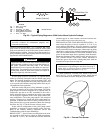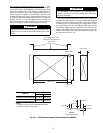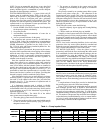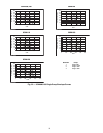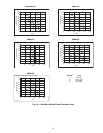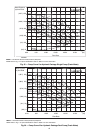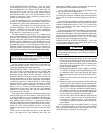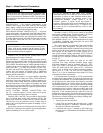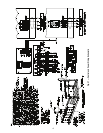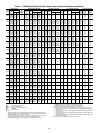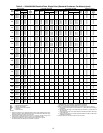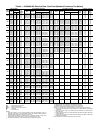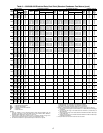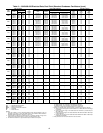
61
PUMP MODIFICATION/TRIMMING — Since the pumps
are constant speed, the only way to obtain greater flow with a
given pump/impeller is to decrease system head. This will
allow the pump to “ride” its curve to the right, resulting in
increased flow. If greater flow is necessary, consider opening
the combination valve. Also, verify that the strainer is clean,
and that no unnecessary system resistance is present, such as
partially closed isolation valves.
Once the combination valve is set, note the stem position. If
later service work requires the valve to be closed, it will be easier
to re-balance the system, if the original balance point is known.
Increasing system resistance by closing the balancing valve
will force the pump to “ride” its curve to the left, resulting in
less flow. Although this does reduce power consumption
slightly, it may not be the desirable method of reducing the
flow, especially if a large reduction is needed.
The other method for reducing flow on a constant speed
pump is impeller trimming. The impellers in the pumps provid-
ed in the 30XA hydronic kit can be easily removed for this
purpose. Refer to the vendor literature packet supplied with the
hydronic package information on Seal Replacement in the
Service section, and follow instructions for impeller removal
and trimming. See Fig. 33 and 34 for pump envelope curve in-
formation. Trimming should only be done by a qualified ma-
chine shop that has experience in this operation. Contact your
local Carrier representative for a recommended machine shop.
Impeller trimming has the added benefit of maximum bhp
(brake horsepower) savings, which can recover the cost
incurred by performing the impeller trimming.
FREEZE PROTECTION — The 30XA units are provided
with a flow switch to protect against freezing situations that
occur from no water flow. While the flow switch is helpful in
preventing freezing during no-flow situations, it does not
protect the chiller in case of power failure during sub-freezing
ambient temperatures, or in other cases where water tempera-
ture falls below the freezing mark. Appropriate concentrations
of inhibited propylene or ethylene glycol or other suitable
inhibited antifreeze solution should be considered for chiller
protection where ambient temperatures are expected to fall
below 32 F (0° C). Consult local water treatment specialist on
characteristics of the system water and add a recommended
inhibitor to the chilled water. The Carrier warranty does not
cover damage due to freezing.
If the pump will be subjected to freezing temperatures, steps
must be taken to prevent freeze damage. If the pump will not
be used during this time, it is recommended to drain the pump
and hydronic package and these components are backflushed
with inhibited glycol. Otherwise, a glycol-water solution
should be considered as the heat transfer fluid. Drains are locat-
ed on the pump(s) and suction guide/strainer for units with hy-
dronic kits. Units without hydronic kits have a drain plug
mounted on the bottom of the cooler head at each end of the
cooler.
NOTE: Do not use automobile anti-freeze, or any other fluid
that is not approved for heat exchanger duty. Only use
appropriately inhibited glycols, concentrated to provide ade-
quate protection for the temperature considered.
Use an electric tape heater for the external piping, if unit
will be exposed to freezing temperatures.
Ensure that power is available to the chiller at all times,
even during the off-season, so that the pump and cooler heaters
have power. Also make sure that the piping tape heaters have
power.
On units with pump packages, a heater is supplied with the
hydronic package that will protect this section from freezing in
outdoor-air temperatures down to –20 F (–29 C), except in the
case of a power failure. The Carrier warranty does not cover
damage due to freezing.
All units are equipped with cooler heaters. Units are protect-
ed from freezing down to 0° F (–18 C) through the cooler heat-
ers and control algorithms. If the unit controls the chilled water
pump and valves, allowing flow through the cooler, the unit is
protected from freezing down to –20 F (–29 C). The Carrier
warranty does not cover damage due to freezing.
PREPARATION FOR WINTER SHUTDOWN — If the unit
is not operational during the winter months, at the end of cooling
season complete the following steps.
1. If the unit has optional heater tapes on the cooler and the
cooler will not be drained, do not shut off power discon-
nect during off-season shutdown. If the unit has optional
heater tapes on the cooler and the cooler is drained, open
the circuit breaker for the heater, CB-13 or shut off power
during off-season shutdown.
2. Draining the fluid from the system is highly recommend-
ed. If the unit is equipped with a hydronic package, there
are additional drains in the pump housing and strainer
that must be opened to allow for all for all of the water to
drain.
3. Isolate the cooler from the rest of the system with water
shutoff valves.
4. Replace the drain plug and completely fill the cooler with
a mixture of water and a suitable corrosion-inhibited anti-
freeze solution such as propylene glycol. The concentra-
tion should be adequate to provide freeze protection to
15° F (8.3° C) below the expected low ambient tempera-
ture conditions. Antifreeze can be added through the vent
on top of the cooler. If the unit has a hydronic pump pack-
age, the pump must be treated in the same manner.
5. Leave the cooler filled with the antifreeze solution for the
winter, or drain if desired. Be sure to deenergize heaters
(if installed) as explained in Step 1 to prevent damage.
Use an approved method of disposal when removing anti-
freeze solution.
At the beginning of the next cooling season, be sure that
there is refrigerant pressure on each circuit before refilling
cooler, add recommended inhibitor, and reset the CB-HT (cir-
cuit breaker heater) (if opened) or restore power.
CAUTION
After trimming, the impeller MUST be balanced. Failure to
balance trimmed impellers can result in excessive vibra-
tion, noise, and premature bearing failure.
CAUTION
Failure to remove power before draining heater equipped
coolers and hydronic packages can result in heater tape and
insulation damage.



